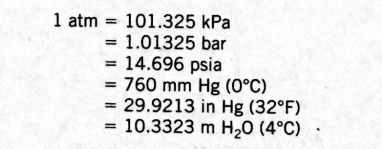Atmospheric Pressure Units Converter (based on 1 atm)
How to Calculate Between Atmospheric Pressure Units
The Atmospheric Pressure Units Converter converts pressure values between standard atmosphere (atm) and equivalent units used in engineering and meteorology. The conversion formula is:
\( P_{output} = P_{input} \times \frac{F_{output}}{F_{input}} \)
Where the factors \( F \) are the equivalents of 1 atm in each unit:
- atm: 1
- kPa: 101.325
- bar: 1.01325
- psia: 14.696
- mm Hg (0°C): 760
- in Hg (32°F): 29.9213
- m H₂O (4°C): 10.3323
Select the input and output units, enter the input value, and calculate the result.
Using the Atmospheric Pressure Units Converter
This calculator is useful for fluid mechanics, HVAC, or barometry, supporting conversions between absolute pressure units referenced to 1 atm, including column heights at specified temperatures.
Select the input unit, output unit, and input the pressure value. The calculator outputs the converted value.
Example 1: Convert 1 atm to psia.
- Input Unit: atm
- Output Unit: psia
- Input: \( 1 \)
- Calculation: \( 1 \times (14.696 / 1) = 14.696 \)
- Result: \( 14.696 \, \text{psia} \)
Example 2: Convert 760 mm Hg to bar.
- Input Unit: mm Hg (0°C)
- Output Unit: bar
- Input: \( 760 \)
- Calculation: \( 760 \times (1.01325 / 760) = 1.0133 \)
- Result: \( 1.0133 \, \text{bar} \)
Use this tool for quick bidirectional conversions in pressure analysis.
Common FAQ
Below are frequently asked questions about atmospheric pressure unit conversions:
- Q: What is standard atmosphere (1 atm)?
A: 1 atm is defined as 101.325 kPa, the average sea-level pressure.
- Q: Why specify temperatures for mm Hg and m H₂O?
A: Column heights depend on fluid density at standard temperatures: 0°C for mercury, 4°C for water.
- Q: Is psia the same as psi?
A: psia is absolute pressure; psi can be gauge, but here it's absolute equivalent to atm.
- Q: How accurate is this calculator?
A: It provides precise results based on standard factors, rounded to 4 decimal places.
- Q: Can negative values be used?
A: No, input values must be positive; invalid inputs leave the result blank.
 Home
Home
 Back
Back
